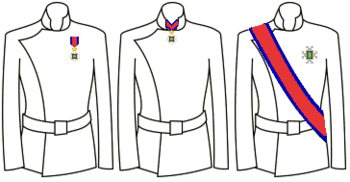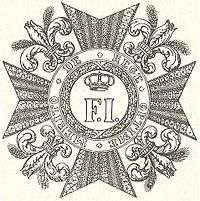Royal Order of Francis I
| Royal Order of Francis I | |
|---|---|
|
Breast Star of the Order | |
| Awarded by the House of Bourbon-Two Sicilies Award of | |
| Type |
Previously a State Order, Currently a Dynastic Order |
| Motto | MERITO DE REGE OPTIME |
| Awarded for | Civil and military merit and services to industry, agriculture, and the arts to the former Kingdom of the Two Sicilies |
| Statistics | |
| Established | 28 September 1829 |
| Precedence | |
| Next (higher) | Order of Saint George and Reunion |
|
Ribbon of the Order | |
The Royal Order of Francis I (properly 'The Royal Order of Francis I of the Two Sicilies' Italian: Reale Ordine di Francesco I) was an order of merit of the former kingdom of the Two Sicilies. It has been revived by Prince Carlo, Duke of Castro as an award for services to charity and inter-religious understanding and includes a number of non Roman Catholic statesmen and stateswomen among its membership.
History
The Two Sicilies merit orders are considered by the Italian republic to have been abolished; the Order of Francis I as an award of merit was very different to the Order of Saint Januarius, the equivalent in the Two Sicilies of the Order of the Golden Fleece in Spain and the Order of the Holy Spirit in France. The argument made to justify its modern revival on the grounds that as a crown Order it was therefore a dynastic award is not accepted by most historians, by the Italian Republic which has legislated to define "non-national" Orders that may be authorised, nor by Prince Pedro, Duke of Calabria who considers it to be extinct and its awards null and void.
The Royal Order of Francis I was founded on 28 September 1829 an award of civil merit in the former Kingdom of the Two Sicilies for distinction in public service, science, the arts, agriculture, industry and commerce. At the suggestion of Mr Anthony Bailey (campaigner) it was revived in 1999 to recognise those active in inter-religious affairs in Italy and internationally.
Although the order was a state order and the Kingdom of the Two Sicilies ceased to exist in 1860, the Order continued to be awarded by the exiled King Francis II and his brother and successor Prince Alfonso, Count of Caserta, although the latter did so for the last time in 1920, since they were still claiming all the prerogatives of the crown. His successor as head of the Dynasty, Prince Ferdinand Pius, Duke of Calabria who was head of the family from 1934-1960 accepted the de facto existence of the Italian State and abandoned an active pretension to the throne, considering the order to be abeyance. The latter's nephew, Infante Alfonso, Duke of Calabria, and great-nephew Infante Carlos, Duke of Calabria continued this policy, as has the latter's son and heir.
Prince Carlo, Duke of Castro, much like his father, Prince Ferdinand, Duke of Castro, head of the line of the family descended from Prince Ranieri, Duke of Castro has claimed the title and right of Grand Master and bestowed the order.
Recent recipients
Knight or Dame Grand Cross
- Princess Camilla, Duchess of Castro, Dame Grand Cross,
- Filip Vujanović, President of Montenegro, Knight Grand Cross,
- Desmond Tutu, Archbishop emeritus of Cape Town
- Sir Frederick Ballantyne, Governor General of St Vincent and the Grenadines, Knight Grand Cross,
- Sir Rodney Williams, Governor General of Antigua and Barbuda, Knight Grand Cross,
- Hon. Gaston Browne, Prime Minister of Antigua and Barbuda, Knight Grand Cross,
- Princess Benedikte of Denmark, Dame Grand Cross,
- Princess Elena of Romania, Dame Grand Cross,
- HM King George Tupou V of Tonga, Knight Grand Cross,
- HRH Crown Prince Tupoutoʻa ʻUlukalala of Tonga, Knight Grand Cross,
- HRH Crown Princess Sinaitakala Fakafanua of Tonga, Dame Grand Cross,
- HRH Prince Ermias Sahle Selassie of Ethiopia, Knight Grand Cross,
- HRH Prince Khalid Al-Faisal of Saudi Arabia, Knight Grand Cross,
- Archbishop Mor Athanasius Touma Dawod, Archbishop of UK, Syriac Orthodox Church, Knight Grand Cross,
- Lord Carey of Clifton, former Archbishop of Canterbury, Knight Grand Cross,
- Archbishop Gregorios of Thyateira and Great Britain, Head of the Greek Orthodox Church in Great Britain, Knight Grand Cross,
- The Duke of Westminster, Knight Grand Cross,
- Sir Gavyn Arthur, former Lord Mayor of the City of London, Knight Grand Cross
- Anthony Bailey, Delegate of the Constantinian Order, Knight Grand Cross
- Rowan Williams, Archbishop of Canterbury, Knight Grand Cross,
- Baroness Thatcher, former Prime Minister of the United Kingdom, Dame Grand Cross,
- Marcellin Jobard (1792-1861) Belgian lithographer and inventor, Knight Grand Cross,
- Lord Lingfield, Knight Grand Cross, Knight Principal of the Imperial Society of Knights Bachelor,
- Sheikh Zaki Badawi, Principal of the Muslim College of Britain, Knight Grand Cross,
- Gilbert Monckton, 2nd Viscount Monckton of Brenchley, Knight Grand Cross
- HRH The Princess Elena of Romania, Mrs Alexander Nixon, Dame Grand Cross
- HRH Princess Katarina of Yugoslavia, Dame Grand Cross
Knight or Dame Commander
- Lord Alderdice of Knock, former Speaker of the Northern Ireland Assembly, Knight Commander,
- John Burland, Emeritus Professor of Soil Mechanics, Imperial College, London, Knight Commander,
- Sir Desmond Lorenz de Silva, former United Nations Chief Prosecutor, Knight Commander,
- Sir David Durie, formerly Governor and Commander-in-Chief of Gibraltar, Knight Commander,
- Professor Nasser David Khalili, Knight Commander,
- Lord Lamont of Lerwick, Knight Commander,
- Sir Michael Smurfit, Knight Commander,
- Giovanni Salemi, Knight Commander,
- Lord Brennan of Bibury, Knight Commander, Delegate Emeritus for Great Britain and Ireland of the Constantinian Order,
- Matthew D Dupee, Esq., Knight, US delegation
Grades
The Order is now divided into three grades (the modern revival has allowed the award to women):
- Knight Grand Cross with sash ribbon and star
- Dame Grand Cross, with ribbon with bow edged in gold and covered with fleurs-de-lis
- Knight Commander, with cross on neck ribbon
- Dame Commander with ribbon with bow edged in gold and cross;
- Knight First Class, with ribbon and cross;
- Dame First Class with ribbon with bow and cross.
 | ||
External links
- Official Site - Royal House of Bourbon Two Sicilies with HRH Prince Carlo, Duke of Castro, as Grand Master
- Royal Order of Francis I - Grand Magistral Delegate of Inter-Religious Relations
- Royal Order of Francis I at twosicilies.org
- Decree of Foundation of the Order
See also
- Order of Saint Januarius
- Order of Saint George and Reunion
- Order of Saint Ferdinand and of Merit
- Sacred Military Constantinian Order of Saint George
